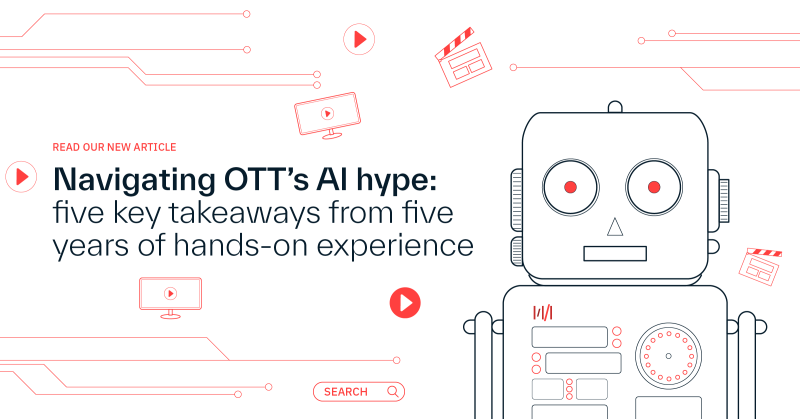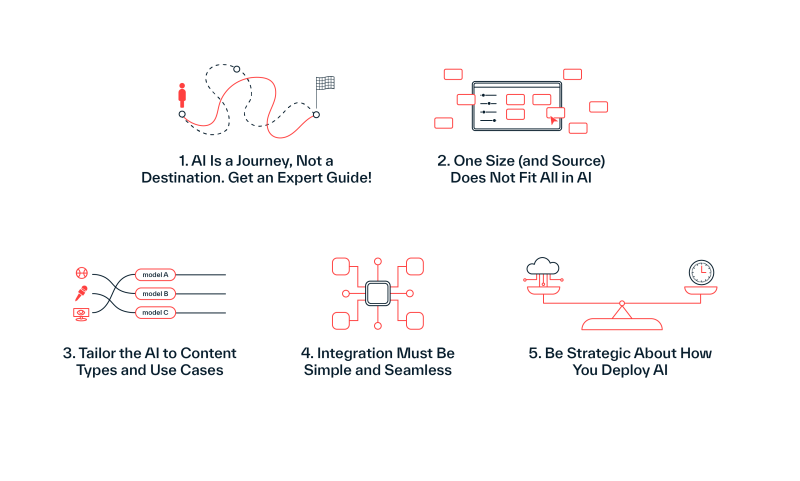
Martin Prins shares five key insights gained from years of working experience with AI
Everywhere you look, industries are being transformed by Artificial Intelligence (AI) and Machine Learning (ML). Consider the impact ChatGPT has had on the world in just one year! In the Media and Entertainment industry, this evolutionary force is driving a new breed of user experiences, and enabling major workflow efficiencies. But is the AI hype backed up by results? And where should Pay-TV and OTT companies start?
At Media Distillery, we haven’t just been talking and observing the AI revolution, we have been actively shaping it for over five years. Our solutions analyse and enhance the value of over 1000 live TV channels every day, improving the viewing UX for 30 million households. This gives us a clear view of the power and potential of AI, as well as the pitfalls to avoid.
In this blog, I will offer a quick overview of what we've learned. You can find more in our e-guide:

5 insights about working with AI for media and entertainment industry
The marketplace is flooded with "off-the-shelf" AI tools from giants like OpenAI, Amazon, Microsoft, and Google. These tools can be a great starting point but they require skilled fine-tuning, training models for your specific needs. Most Pay-TV operators and OTT services don’t have the budgets for that, so they’re looking for a full-service AI solution.
The Media Distillery team doesn’t just select, design, and deploy AI models, we’re constantly blending and tuning those models to extract the best value from video content. Topic Distillery is a great example. This award-winning solution uses many forms of AI: ML, Deep Learning, and Generative AI to delve deep into live, unscripted programming and identify the content nuggets that will attract and engage viewers but can’t be easily be discovered in many services today due to a lack of descriptive metadata. No off-the-shelf solution is going to give you all that.
The AI landscape is vast and varied. For the best results, we have learned you need to be flexible about where you source your AI, ML, Deep Learning, and Large Language Models (LLMs). At Media Distillery we’ve spent years building our Deep Content Understanding Platform, into which we can plug a broad selection of tools: open-source tools and models, proprietary solutions, and our in-house models. This best-of-breed approach gives us the flexibility to support many use cases and achieve the best possible value for our customers while remaining cost-effective.
We learned very early on in this journey that media companies have broadly similar needs to each other, but different (enriched) metadata requirements for different content types. That’s why we always advise our customers to focus on the OUTCOME they want to achieve, rather than the TOOLs or metadata they think they need. They are often surprised to learn that “less (data) means more”, that expensive technology X actually isn’t needed at all to achieve their desired goals, or that we recommend different approaches between, for example, sports content and news/current affairs.
When Topic Distillery is used to identify the segments in a news or current affairs show, as we do for Dutch OTT aggregator NLZIET, then providing a short but specific synopsis as a visual guide helps the user decide what to watch. Details such as the locations and people mentioned in the report enhance their understanding. By contrast, in sports content, putting too much detail in the title (the score for example!) could spoil the viewing experience completely.
We also understand the importance of speed in the streaming industry. We’re focused on improving the near-live and replay UX for consumers because that delivers the engagement and loyalty that impacts a service provider’s bottom line. But if your enhanced metadata takes 24 hours to appear, it’s missed the majority of its target. That’s why our models are also tuned for speed.
Many media companies hope AI will be an enabler for a competitive edge. But that edge shouldn’t come at the expense of operational efficiency. The last thing any video service needs is to complicate existing workflows. That’s why we have prioritised ease of integration.
With Topic Distillery, just like our popular EPG correction solution, our customers simply deliver us an SRT feed of the channel to be analysed, or a link to the cloud-hosted stream, and we handle everything. The output is a package of live-generated, actionable metadata that’s delivered either directly to your API endpoint or through an existing Metadata provider (e.g. Gracenote, Simply.TV, or Media Press). This flexibility allows for an enhanced user experience, without the hassle of an additional integration.
In a world where AI and cloud-based tools often come with usage-based pricing, cost management is crucial. As the expression goes, you don’t want to use a sledgehammer to crack a nut. We help our customers deploy AI where it adds the most value, starting with specific channels or shows and scaling up as the benefits become evident. The goal here is to invest in AI intelligently and where it matters most, enhancing your service without unnecessary expenditure.
Most Pay-TV and OTT companies are just getting started on their AI journey. It’s going to be an ongoing adventure that requires expertise, strategic thinking, and a deep understanding of the industry.
Are you intrigued by what AI can do for your video service UX and how it can be seamlessly integrated into your operations? Find out more in our ebook, or book a demo and see our solutions in action.
December 12, 2023